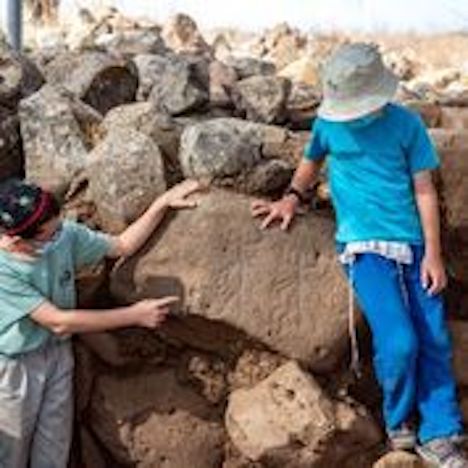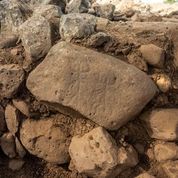
The complex was exposed in archaeological excavations carried out by the
Israel Antiquities Authority, prior to the construction of a new neighborhood
in Hispin by the Ministry of Housing and Construction and the Golan
Regional Council.
In the excavation, carried out predominantly by local residents and youth, a rare stone carved with two horned figures with outspread arms, was discovered.
According to the archaeologists, “It is probable that the fort was manned by the Geshurites, who ruled in the Southern and Central Golan, and carried out diplomatic relations with King David and the Davidic Dynasty.”

A fortified complex from the time of King David (Iron Age, eleventh to tenth centuries BCE)
was exposed for the first time in archaeological excavations carried out by IAA in Hispin in the Golan Heights. The archaeologists consider that the fort was built by the kingdom of Geshur, the ally of King David, in order to control the region. The excavation was undertaken prior to the construction of a new neighborhood in Hispin, and funded by the Ministry of Housing and Construction and the Golan Regional Council, with the participation of many residents of Hispin and Nov, and youth from the pre-military academies at Natur, Kfar Hanasi, Elrom, Metzar and Qaztrin.
According to Barak Tzin and Enno Bron, Excavation directors on behalf of the Israel
Antiquities Authority,“The complex we exposed was built at a strategic location on the small hilltop, above the El-Al canyon, overlooking the region, at a spot where it was possible to cross the river. The c. 1.5 m wide fort walls, built of large basalt boulders, encompassed the hill. In the excavation, we were astonished to discover a rare and exciting find: a large basalt stone with a schematic engraving of two horned figures with outspread arms. There may also be another object next to them.”
It is noteworthy that in 2019, a figure carved on a cultic stone stele was found in the Bethsaida Expedition Project, directed by Dr.Rami Arav of Nebraska University, at Bethsaida just north of the Sea of Galilee. The stele, depicting a horned figure with outspread arms, was erected next to a raised platform (bama) adjacent to the city gate. This scene was identified by Arav as representing the Moon-God Cult. The Hispin stone was located on a shelf next to the entrance, and not one, but two figures were depicted on it. According to the archaeologists, “it is possible that a person who saw the impressive Bethsaida stele, decided to create a local copy of the royal stele.”
The fortified city of Bethsaida is considered by scholars, to be the capital of the Aramean
Kingdom of Geshur, that ruled the central and southern Golan 3000 years ago. According to the Bible, the kingdom upheld diplomatic and family relations with the House of David; one of David’s wives was Maacah, the daughter of Talmi, King of Geshur.
Cities of the Kingdom of Geshur are known along the Sea of Galilee shore, including Tel En
Gev, Tel Hadar and Tel Sorag, but sites are hardly known in the Golan. This unique fortified
complex raises new research issues on the settlement of the Golan in the Iron Age.
Following this discovery, changes in the development plans will be carried out together with the Ministry of Housing and Construction, in order that the unique fortified complex will not be damaged. The complex will be developed as an open area along the El-Al river bank, where educational-archaeological activities will be carried out, as part of the cultural heritage and a link with the past. This aligns with the Israel Antiquities Authority’s policy that learning the past through experiencing work in the field, strengthens the young generation’s bonds with their roots.
